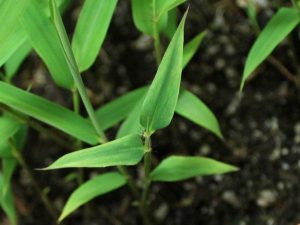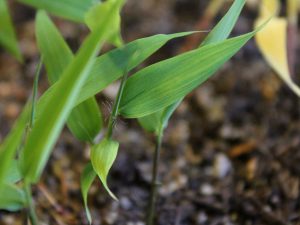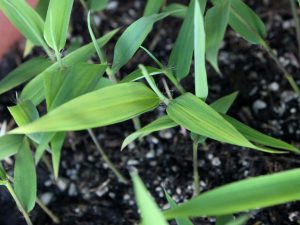
New Batch of Bamboo Seedlings
In early winter, I have germinated 10 Phyllostachys arcana ‘Luteosulcata’ bamboo seedlings to test germination rate. I stored the rest to start growing them later. To preserve space I decided to germinate the majority in late winter, so that they can be moved outside as soon as possible.
Their time arrived and I placed all the seeds into relatively small pot that should be enough for them to start showing some of their basic characteristics. The best part of growing bamboo seedlings is the fact, that some of them may show extra features like variegation, cold-hardiness, sun tolerance, drought resistance or how vigorous the plant is. Many characteristics are not visible until later, when bamboo gets mature enough, but some can be evident from the very beginning. Some of the seedlings are strong from the beginning, and there are always seedlings, that “complain” about everything and rarely live more than a couple of years. The goal is to find any possible seedling that would end up having any of the genetic treats that would make it special. It’s fairly easy to start the seeds, but eventually they start taking a lot of space and you have to make selections and decide which of the seedlings are worth keeping.

Among albino seedlings that are too degenerated to survive, there are usually some variegated seedling that are healthy enough to survive. They may lack vigour and would have trouble surviving from seed in the wild, but with some help, they can be grown to the point, when they can thrive. Variegation often shows later in plants development and sometimes, even if the seedling shows some signs of variegations early, those features can fade away completely as bamboo gets maturer. That’s why you can’t really tell how special bamboo plant is, unless it’s completely healthy and growing for some time. Based on observation, you can pick good candidates that could eventually become worth growing for whatever reason.
I’ve had some luck during the germination trial and one of the plants appeared with serious issues producing chloroplasts, which results in unnaturally pale and variegated bamboo seedling. Low photosynthesis rate makes it grow much slower, but with some pampering, I was able to keep it alive. With all the remaining seeds (at least ten times more seeds), the number of variegated seedling should be even greater. It was not.

There were many seedlings that started showing some minor striping on their first couple of leaves, but those are usually just temporary and will eventually fade out. They can develop some sort of variegation later, so if they are growing healthy, it’s worth growing them for a while longer. One of the seedlings shows more pronounced white striping and even some kind of leaf deformation. I have yet to see if it’s just deformed and will perish before it’s first shoot, or perhaps it’s just showing first signs of variegation.


One of the seedlings is showing similar variegation to that first seedling from the test round. It has similar striping and also fades from pale green to yellow leaf with green stripes, but it’s much darker in the beginning and it actually shows some stripes that are completely green right after the leaf unfolds. If that doesn’t change, it may become more vigorous and healthy, but greener version of my previous variegated seedling.
There are also other bamboo seedlings that also show signs of variegation, but I intend to wait a while for them to become more evident. I’ll update this post in a week or so.